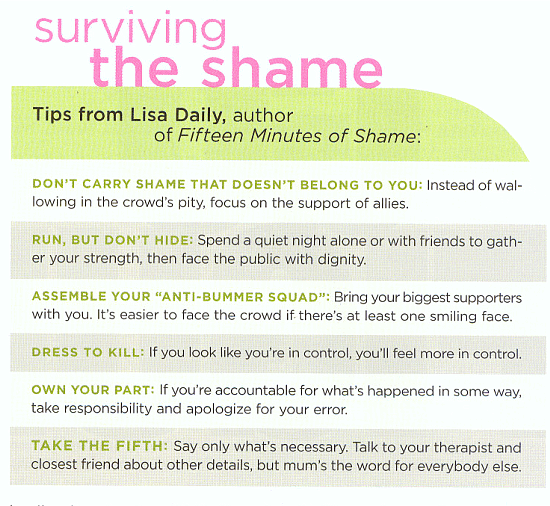Pink
15 Minutes of Shame
I’m proof it’s possible to reclaim dignity – and career momentum – after a public humiliation.
By Lisa Earle McLeod
Who Hasn’t Been There?
 You down too many glasses of Shiraz at the annual banquet. You say the wrong thing to an important client. Or you march up to the podium for your big presentation with three squares of Charmin dragging from your Christian Louboutin. When it happens, it seems like all eyes are upon you.
You down too many glasses of Shiraz at the annual banquet. You say the wrong thing to an important client. Or you march up to the podium for your big presentation with three squares of Charmin dragging from your Christian Louboutin. When it happens, it seems like all eyes are upon you.
My own career embarrassments run the gamut. Let’s see: There’s the time I wore a see-through blouse on my second day of work at Procter & Gamble. Then there’s the infamous breast-leakage incident, when I gave a seminar for 150 people with two giant bull’s-eyes on my chest (note to self: nursing mothers should never wear silk). And I’ve even had horrific lapses in judgment, like when I got so soused the night before a management meeting that I spent the entire next day in a bathroom stall.
But what if your shame results from something even more public, and more humiliating, than a wardrobe malfunction or one too many gin and tonics? How do you respond when your love life becomes water cooler gossip? Or your fight with the IRS makes its way into the local paper? Or your big project fails miserably and the CEO starts referring to it in memos as “Carolyn’s $12 million mistake”?
 Some missteps are so horribly humiliating that they can make a normally confident, successful woman want to bury her head under the covers and skip work the next day. Boeing exec Debra Peabody resigned amid a flurry of media attention after her affair with CEO Harry Stonecipher became public. Martha Stewart’s insider trading debacle cost her control of her company and made her the butt of endless jokes. And even country music darling Faith Hill was tempted to scrap her tour plans after a 30-second clip of her own sore-loser’s reaction at the CMA Awards hit YouTube. “It was hell,” Hill says, “I was being ripped apart limb to limb. I wanted to quit.”
Some missteps are so horribly humiliating that they can make a normally confident, successful woman want to bury her head under the covers and skip work the next day. Boeing exec Debra Peabody resigned amid a flurry of media attention after her affair with CEO Harry Stonecipher became public. Martha Stewart’s insider trading debacle cost her control of her company and made her the butt of endless jokes. And even country music darling Faith Hill was tempted to scrap her tour plans after a 30-second clip of her own sore-loser’s reaction at the CMA Awards hit YouTube. “It was hell,” Hill says, “I was being ripped apart limb to limb. I wanted to quit.”
In her latest novel, Fifteen Minutes of Shame (Plume, March 2008), author and relationship expert Lisa Daily explores the very public career fallout faced by a fictional TV love expert when she learns her husband is cheating. In one of the book’s most memorable (and wickedly funny) scenes, the heroine, super-successful careerist Darby Vaughn, is sent reeling when Today anchor Matt Lauer shocks her on live television with news that her husband is leaving her. Her poised, “I know everything about men” persona collapses as she throws up into the basket of chrysanthemums on the Today coffee table.
Granted, most of us won’t ever face a pack of camera-wielding stalkarazzi, or a nauseating surprise on national TV, but virtually everyone can relate to the “one minute you’ve got it all together, the next minute you’re sobbing in the bathroom” experience. And given my own history of shameful slip-ups, that got me thinking about how to get one’s career back on track when it seems like the whole world – or at least your whole staff – is whispering behind your back.
“When we’re going through something embarrassing, our instinct is to run and hide,” Daily tells me, “but that nearly always spells the death of a career.” So, step one: Face the faux pas. Next, according to media coach and public relations expert Susan Harrow, we need to ask, “Is the shame mine?” Cheating spouses, delinquent kids and embezzling brothers-in-law are embarrassing, but they’re more likely to evoke compassion than ridicule. And even if you were the one who got drunk at the party, or made someone mad, “It’s uncomfortable, but it’s not fatal,” Harrow says, “You want to shift the focus as quickly as you can to something more positive.” In other words, the faster you get your nose back to the grindstone, the less likely you are to become the object of ridicule.
Too many of us may assume that revealing a crack in our armor makes us seem unsuited for leadership, or that if we don’t have control over our personal lives, no one will ever trust us with the P&L. But Harrow, who trains numerous Top 500 CEOs, says our ability to handle a dicey situation with dignity and grace usually endears us to people instead of provoking their distrust.
Public pity may seem like the last thing we want to add to our portfolios. But lest we think sympathy isn’t compatible with leadership, Harrow reminds us of “a certain blond senator from New York who saw her public stock – and her public power – rise after her presidential spouse was caught with his hand on the cigar.” Daily refers to this tipping point as “The Kathie Lee Factor” – the simple truth that the public loves to see a woman who seems to have it all get knocked off her pedestal.
You can tip the right way – as when Hillary Clinton and Martha Stewart came out stronger after scandals because they acknowledged the problem and moved forward – or the wrong way – as when Kathie Lee Gifford simply disappeared in embarrassment after the media revealed her husband’s infidelity.
However, if you’ve alienated the firm’s biggest client, or accidentally pushed Reply All with a ranting e-mail meant only for a friend, simply moving on isn’t enough. Serious damage control is a must. Harrow advises that the first step is to take responsibility and apologize as quickly as you possibly can. “If everyone in your firm knows about it, you need to make a global announcement, but if they don’t know, then individual private apologies are in order.” She adds, “Tone is everything; when you say you’re sorry, really mean it.” And an especially expensive bottle of Dom Pérignon or an all-expenses-paid spa visit for the slighted party probably wouldn’t hurt either.
In the end, Harrow affirms what I’ve come to realize through my own business career: True leadership is revealed in one’s response to challenges – even the personally embarrassing kind. If recent public scandals have proven anything, it’s that no matter how bad things seem at the time, nothing is unrecoverable. Because while it’s always intriguing to see someone fall, it’s far more compelling to watch them get back up.


